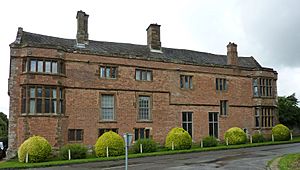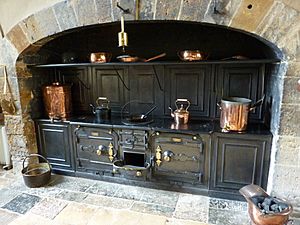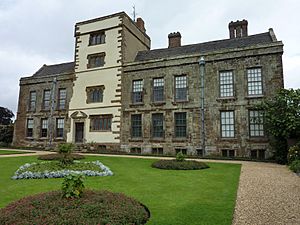Canons Ashby House facts for kids
Quick facts for kids Canons Ashby House |
|
|---|---|

Front of Canons Ashby House
|
|
| Location | Canons Ashby, Daventry, Northamptonshire, England, NN11 3SD |
| Architectural style(s) | Elizabethan |
| Governing body | National Trust |
|
Listed Building – Grade I
|
|
| Official name: Canons Ashby House | |
| Designated | 18 September 1953 |
| Reference no. | 1075304 |
| Lua error in Module:Location_map at line 420: attempt to index field 'wikibase' (a nil value). | |
Canons Ashby House, once called Canons Ashby Hall, is a beautiful old country house in England. It's found in the village of Canons Ashby, about 18 kilometers (11 miles) south of Daventry in Northamptonshire. This amazing house was built a long time ago, during the Elizabethan era.
The National Trust has owned Canons Ashby House since 1981. They saved it when it was almost falling apart and its gardens were just a field. A part of the house, called "The Tower," is looked after by the Landmark Trust and can even be rented for holidays!
Contents
What Makes Canons Ashby House Special?
The inside of Canons Ashby House is famous for its old wall paintings from the Elizabethan period. It also has beautiful plasterwork from the Jacobean period. The house has stayed mostly the same since 1710. It looks much like it did when Sir Henry Edward Leigh Dryden lived there. He was a Victorian historian who loved old things.
The house is surrounded by a lovely formal garden. This garden has colorful flower beds and an orchard with fruit trees from the 1500s. You can also see old terraces, walls, and gate pillars from 1710. There are even parts of a medieval church nearby. This church, Canons Ashby Priory, is where the house gets its name.
A Look at the House's History
Canons Ashby House has been the home of the Dryden family for centuries. The main part of the house was built around 1550. More sections were added in the 1590s, 1630s, and 1710.
Early Dryden Family and Anne Hutchinson
In 1551, a man named John Dryden married Elizabeth Cope. Through his wife, he inherited a farmhouse. He slowly made it bigger, turning it into the house we see today. John and Elizabeth had a daughter named Bridget Dryden. She was born at Canons Ashby in 1563.
Bridget later married Francis Marbury, a teacher. Their daughter, Anne Hutchinson, was born in 1591. Anne moved to America in 1634, to the Massachusetts Bay Colony. She had strong religious beliefs that were different from the leaders there. Her ideas caused some disagreements. Anne was eventually asked to leave the colony.
In the 1800s, Americans saw Anne Hutchinson as a hero for religious freedom. In the 1900s, she was also seen as a leader for women's rights. Today, a statue of Anne Hutchinson stands in front of the Massachusetts State House in Boston.
Changes Over the Years
In the 1590s, John's son, Sir Erasmus Dryden, 1st Baronet, finished the north part of the house. This created the Pebble Courtyard. He also added fancy decorations inside, like a fireplace in the drawing room and paintings in Spenser's room. His son, Sir John Dryden, 2nd Baronet, inherited the house next. He added a beautiful plaster ceiling to the drawing room.
Later, Edward Dryden, a descendant, focused on the garden. He created a formal garden with terraces.
Sir Henry Edward Leigh Dryden took over the house in 1837. He created the book room, which held many old documents. His daughter, Alice Dryden, was born in the house in 1866. She was a historian and photographer. She took many valuable pictures of the house. Alice lived there for 33 years. After her father passed away, she moved out because women could not inherit the estate then. It went to her uncle, Sir Alfred Erasmus Dryden.
Canons Ashby in Modern Times
During World War II, the London offices of 20th Century Fox films moved to Canons Ashby House. The staff lived in a nearby village. After the war, the Dryden family moved to Rhodesia. They rented out the house to different people.
Louis Osman, a famous British goldsmith and architect, lived at Canons Ashby from 1969 to 1979. While there, he and his wife, Dilys Roberts, made the crown used for the investiture of Charles, Prince of Wales in 1969. They also made a special gold box that held the Magna Carta. This box was shown in Washington, D.C., in 1976 for the United States Bicentennial.
In the 1980s, Gervase Jackson-Stops helped save the house. He was an advisor to the National Trust. This was the first time the National Trust used its own money to save a historic house. Usually, families would give money to help.
Exploring Inside the House
The Great Hall
This large room was part of the original house built in the 1550s. It was made bigger in the 1600s. In the early 1700s, Edward Dryden decorated it in a medieval style. He added armor and family symbols. There's also a painting above the fireplace by Elizabeth Creed, a family cousin. She also painted a life-size cutout of a soldier that you can see in the room.
The Dining Room
Edward Dryden redecorated this room in 1710. He added new windows and oak wood panels. Many family portraits hang on the walls. These include a painting of the poet John Dryden by Godfrey Kneller. There's also a painting of Elizabeth Cornwallis, Edward's mother-in-law, as the goddess Diana. A special walnut mirror above the fireplace was put in at the same time as the wood panels.
The Book Room
Sir Erasmus Dryden added this room in the 1590s. It has wood panels and a fireplace with Doric columns. The panels above the fireplace might have come from the Cope family home. Sir Henry Dryden, who loved history, changed this room in the mid-1800s. He made it a place to read books, not just a library to borrow them from. Many original books were sold in the 1900s. However, the National Trust has bought back many books connected to the house. A self-portrait by Elizabeth Creed also hangs here.
The Drawing Room
This room is part of the original Elizabethan house. It has rich decorations added over time. The large fireplace was put in during the 1590s and painted to look like marble. Sir John added the domed ceiling and the family crest above the fireplace in the 1630s. In 1710, Edward Dryden added panels above the fireplace showing the family's coat of arms. You can also see watercolors by Clara Dryden, showing scenes from Canons Ashby in the 1890s.
Spenser's Room
This bedroom is named after the poet Edward Spenser. He was a cousin by marriage to Sir Erasmus. People say he wrote part of his famous poem, The Faerie Queene, during a visit here. When the house was restored in the 1900s, rare Elizabethan wall paintings were found behind the 1700s wood panels. These well-preserved paintings show the story of Jeroboam from the Bible. They warn about worshipping false gods.
The Tapestry Room
This room dates back to the 1560s. It was changed several times over the years. The Flemish tapestries hanging in the room are from the 1600s. The bed was made in the 1800s by Sir Henry. It includes carvings from the Jacobean period. The room also has an embroidered settee from the early 1700s. It was made for Edward Dryden. The family sold it between the World Wars. But the National Trust bought it back in 1983 with help from a kind donor.
The Servants' Hall
This room was created in the 1580s. It was first used as a private dining room for the family. In 1710, when Edward Dryden made a new dining room, this room became a dining space for servants. The most interesting things here are the painted panels. Sir Erasmus added them in the 1590s. They show family crests and Latin sayings about good behavior. The crests represent family connections and important families nearby.






